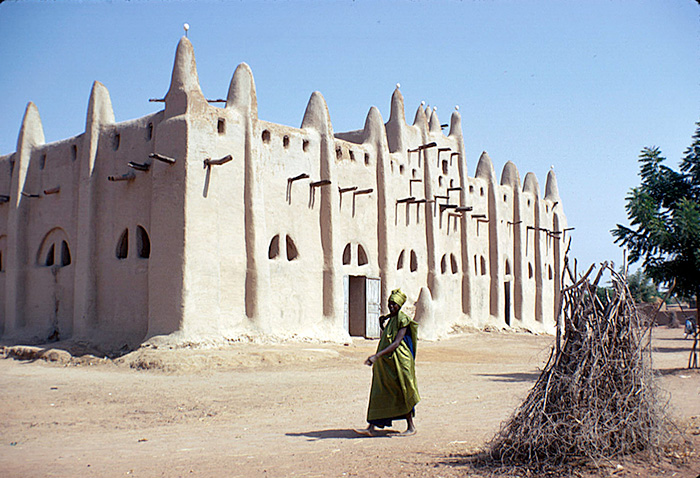The largest adobe building in the world is located Djenné, Mali. Built in 1907 and towering above the town’s central square, the Great Mosque of Djenné is a prime example of Western Sudanic architecture. In fact, UNESCO designated the structure and its surrounding town a World Heritage Site in 1988. But beyond its veneer of cultural cachet is a history of debate and communal ties that only adds to the site’s boundless splendor.
The Great Mosque of Djenné, which draws from Moroccan and Tukolor (a nineteenth century West African empire) influences, is but one structure in a network of rural adobe buildings, each requiring regular reapplication of calcite-rich building mud. The mosque, in particular, requires annual re-claying—a tradition that holds aesthetic and spiritual significance for the town’s mud masons. In fact, the wooden sticks which emphasize the clean lines of the structure double as climbing aids for the mosque’s masons.
For Lassina Kouroumansé, who has been practicing masonry for almost forty years, the act of remudding is a communal one. “All my life I have wanted to be a mason, to work with the earth and the mud,” Kouroumansé explained. “There is no job like it.”
But, for all its charms, the Great Mosque has also found itself at the center of a Djenné-wide debate: one of traditional versus modern design. Under UN rules for heritage sites, residents are forbidden from modernizing their homes, a restriction that extends to building interiors. This friction, coupled with the pivot to younger masons over ancestral masters, underlies the town’s dispute. Tensions came to a head in 2009 when much of the Great Mosque’s mud was stripped away to preserve its structure, resulting in a thinner frame with fewer handmade nuances characteristic of the original.

As Djenné’s tradition of mud masonry wanes, it risks losing a system of learning and community-building. Salif Droufo, who inherited the trade from his mother’s side of the family and apprenticed with Kouroumansé, wants his son to follow in his footsteps and keep up the tradition for years to come.
Konbaba Tennepo, one of the town’s master masons, agrees. “My children plead, ‘Papa, stop working,’ but I cannot because I love this trade. I cannot leave my work.”
For many, mud masonry is an education on its own. As Kouroumansé put it, “Djenné is my school.”
One gets the sense that the value of the Great Mosque of Djenné lies less in its status as a World Heritage Site and more in its strategic placement in a community of skilled craftsmen. In spite of the friction the town’s status has caused, Djenné’s communal ties have proven stronger than its mud walls.

This piece was written in association with the Smithsonian Arthur M. Sackler Gallery exhibition, The Art of the Qur’an: Treasures from the Museum of Turkish and Islamic Arts, on view through February 20, 2017.


